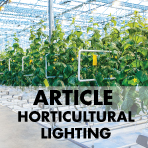Introduction to horticultural lighting
Plants have a completely different sensitivity to light colours. Contrary to other lighting applications which are made for humans and valued in luxes, plants consume light and need photons for photosynthesis. The amount and ratio of different wavelengths from the light determine how, and how fast, plants grow and produce crop. Regardless of different seasons or unstable weather today’s artificially created horticultural lighting can mimic any daylight integral and have stable, optimized growing conditions for each plant.
Some terms to know:
The
photosynthetic photon flux (PPF), which comes from the total amount of
photosynthetically active radiation (PAR), is what has the most effect on how strong plant growth will be. More PPF means more photons and more power, and this value can be easily measured and used as a parallel to lumens. On the other hand
photosynthetic flux density (PPFD) means how many of the photons actually hit their target, and this can be related to luxes.
Application areas:
Top lighting – Greenhouses: Illumination of the hall and plants from ceiling level.
Top lighting – Vertical farming: Illumination from top of the plants at close distance.
Intra-canopy: Illumination on the side or in between the plants.
Find products for horticultural lighting
ARTICLES AND WHITEPAPERS

